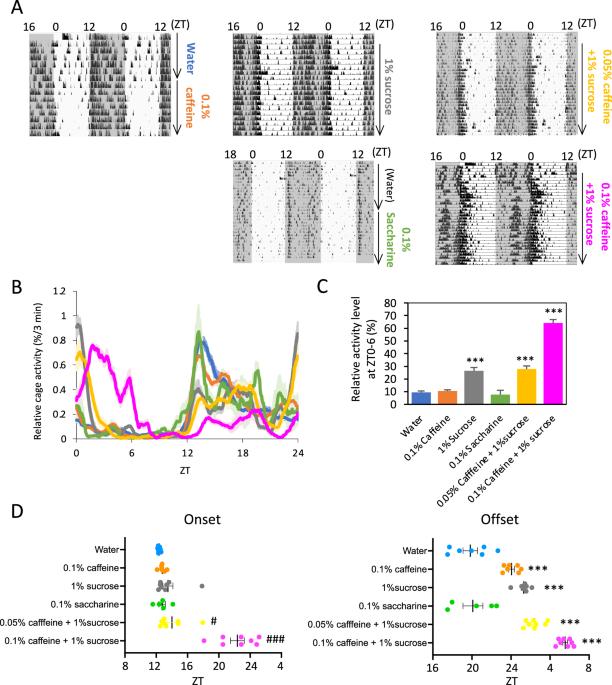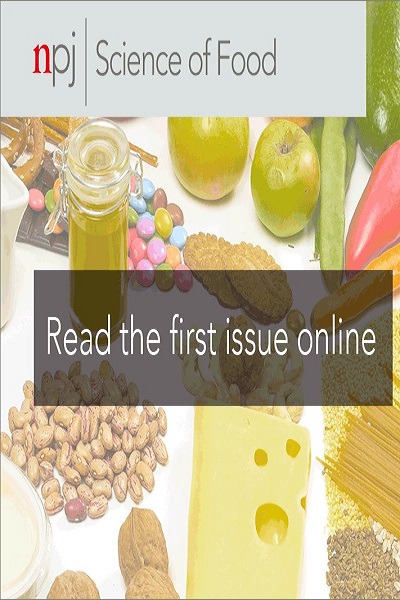雄性小鼠饮用加糖咖啡因的行为节律与中枢昼夜节律无关。
IF 6.3
1区 农林科学
Q1 FOOD SCIENCE & TECHNOLOGY
引用次数: 0
摘要
咖啡因的摄入与傍晚时型有关,给小鼠服用咖啡因会导致运动活动的昼夜节律时间延长。然而,由于咖啡因是苦味的,人类和小鼠都喜欢甜味的咖啡因;然而,它对昼夜节律的影响还没有被探索过。在这项研究中,小鼠可自由摄入加糖咖啡因,以研究其对行为节律和外周时钟的影响。自由摄入甜咖啡因的小鼠从夜间活动节律转向昼夜活动节律。除了光-暗诱导的行为节律成分外,一些动物还表现出超过 24 小时的自由活动期。在光照阶段开始时腹腔注射咖啡因也能急性诱导昼伏夜出行为。即使是在恒定光照下饲养的小鼠或下丘脑上核中枢昼夜节律钟受损的小鼠,也能观察到甜咖啡因导致的长周期(26-30 小时)行为节律,但节律性不稳定。饮用咖啡因期间,通过体内全身成像测量肾脏等外周组织的 PER2::LUCIFERASE 节律,结果显示个体间的节律振幅减小,相位不同步。这些结果表明,摄入甜味咖啡因会诱发昼夜和长周期行为节律,而与中枢时钟无关,从而导致体内时钟不同步。本文章由计算机程序翻译,如有差异,请以英文原文为准。

Sweetened caffeine drinking revealed behavioral rhythm independent of the central circadian clock in male mice
Caffeine consumption is associated with the evening chronotype, and caffeine administration in mice results in prolonged period of the circadian rhythm in locomotor activity. However, as caffeine is bitter, sweetened caffeine is preferred by humans and mice; yet, its impact on the circadian clock has not been explored. In this study, mice were provided with freely available sweetened caffeine to investigate its effects on behavioral rhythms and peripheral clocks. Mice that freely consumed sweetened caffeine shifted from nocturnal to diurnal activity rhythms. In addition to the light-dark entrained behavioral rhythm component, some animals exhibited free-running period longer than 24-h. Intraperitoneal administration of caffeine at the beginning of the light phase also acutely induced diurnal behavior. The behavioral rhythms with long period (26–30 h) due to sweetened caffeine were observed even in mice housed under constant light or with a lesioned central circadian clock located in the suprachiasmatic nucleus of the hypothalamus; however, the rhythmicity was unstable. PER2::LUCIFERASE rhythms in peripheral tissues, such as the kidney, as measured via in vivo whole-body imaging during caffeine consumption, showed reduced amplitude and desynchronized phases among individuals. These results indicate that consumption of sweetened caffeine induces diurnal and long-period behavioral rhythms irrespective of the central clock, causing desynchronization of the clock in the body.
求助全文
通过发布文献求助,成功后即可免费获取论文全文。
去求助
来源期刊

NPJ Science of Food
FOOD SCIENCE & TECHNOLOGY-
CiteScore
7.50
自引率
1.60%
发文量
53
期刊介绍:
npj Science of Food is an online-only and open access journal publishes high-quality, high-impact papers related to food safety, security, integrated production, processing and packaging, the changes and interactions of food components, and the influence on health and wellness properties of food. The journal will support fundamental studies that advance the science of food beyond the classic focus on processing, thereby addressing basic inquiries around food from the public and industry. It will also support research that might result in innovation of technologies and products that are public-friendly while promoting the United Nations sustainable development goals.
 求助内容:
求助内容: 应助结果提醒方式:
应助结果提醒方式:


